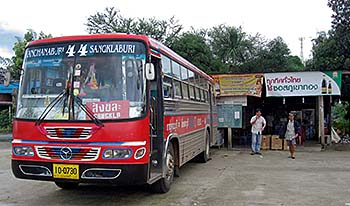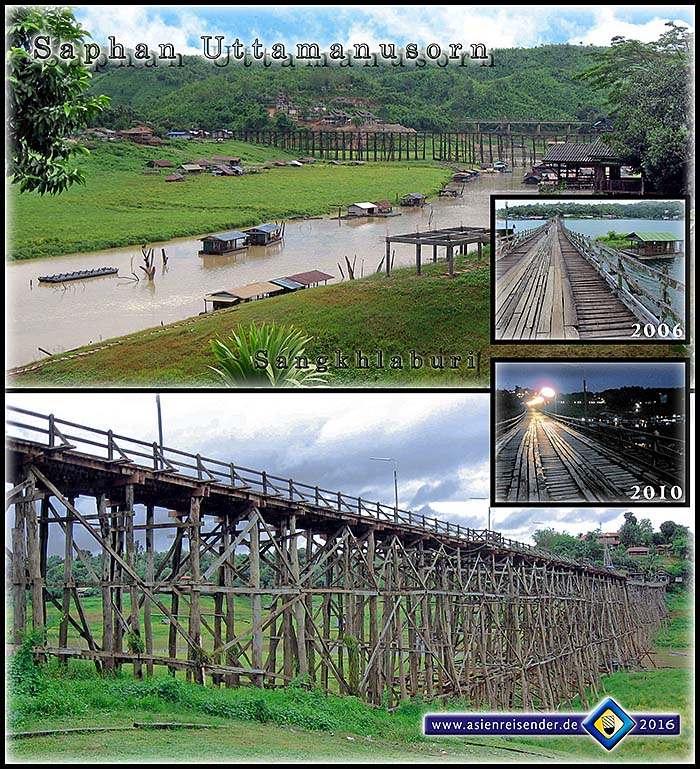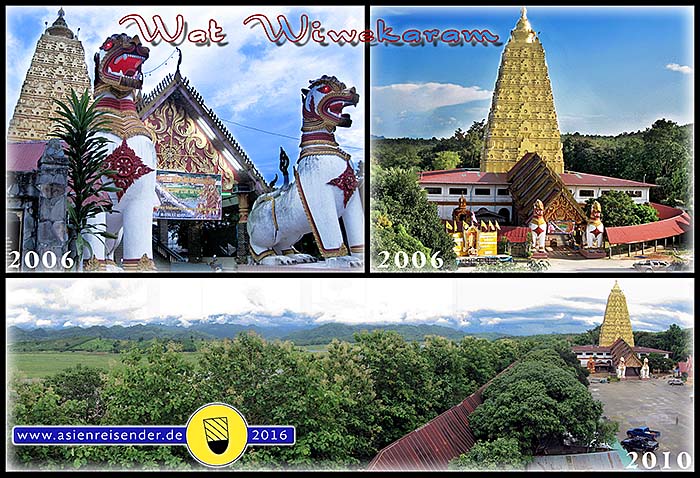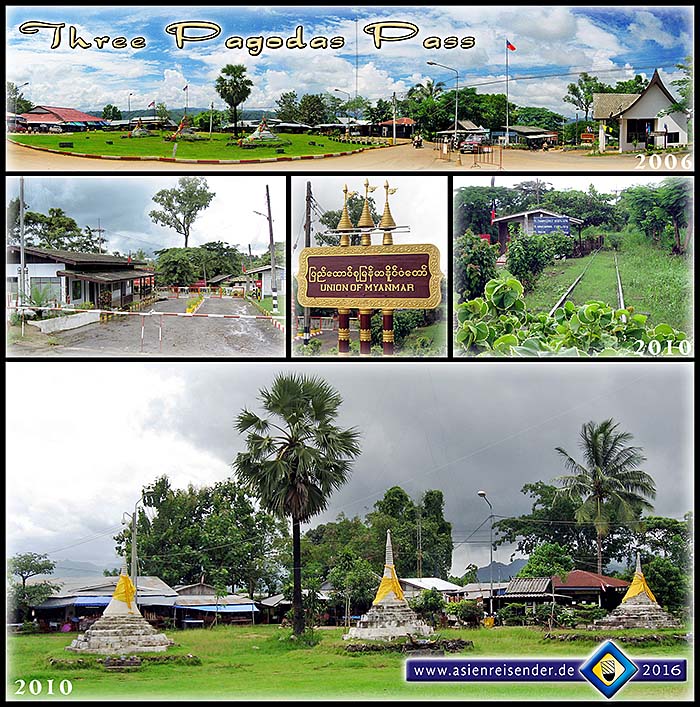Sangkhlaburi
Sangkhlaburi is a small district town in the Tenasserim Mountains at the western edge of central Thailand. These mountains are still densely forested, and, for our times, few people live here. The place's surroundings are coined by Khao Laem Lake, an artificial lake which is dammed by Vajiralongkorn Dam. Many streams who flow out of the mountains come here together; the resulting river, which leaves the lake, is Khwae Noi, called by Westerners the River Kwai. The district belongs to Kanchanaburi Province.

Usually, there is one bus at the station, who goes to Kanchanaburi. Image by Asienreisender, 8/2010
After the place was a couple of years ago promoted in Thai TV, it started to attract a growing number of Thai tourists. They come here, often from Bangkok, on weekends and holidays to spend time in the restaurant boats on Khao Laem Lake. Also a few Western tourists find their way out here, but there are not many. Sangkhlaburi is a remote place.
There are no big touristic sites in Sangkhlaburi, but a few places worth being visited. In direct neighbourhood of the town is Saphan Mon (the Mon Bridge, official name Uttamanusorn Bridge), of which is said it were the largest handmade wooden bridge in Thailand. It's indeed of a large size and length (400m). Saphan Mon connects Sangkhlaburi with Wang Kla, a Mon village on the other side of the lake. The bridge was first built, according to hearsaying, in the mid 1980s.

The large wooden bridge between Sangkhlaburi and Wang Kla is the most impressive building in the area. It's handmade and requires regularly maintainance.
Remarkable are the differences in the water level. In October 2006 the level was very high, almost up to the bridge's railing. In August 2010 there was no lake here, merely a river valley.
Images and photocomposition by Asienreisender, 10/2006, 8/2010, 2016
Wang Kla is a place which came in existence in 1949, short after the Second World War. It was founded by Mon People who fled Burma. The village consists of a growing number of wooden houses in a traditional and simple style. There is absolutely nothing particular in this village. However, not too far outside, easily in walking distance from Sangkhlaburi, lies the remarkable temple Wat Wang Wiwekaram.
The temple's chedi (Chedi Buddhakhaya) is a landmark in the whole area. It's a Buddhist temple which is built after the model of an Indian temple in Bihar. The whole construction is therefore completely unusual for Thailand. At the foot of the temple is an archway integrated in which the unavoidable traders sit. One get's here a great variety of goods from neighbouring Burma/Myanmar. Among all the many spices and wood carvings and household items are also precious stones, of who most of them are not so precious as it's claimed they were. A Thai woman who lives in Sangkhlaburi told me that she lost quite an amount of money buying stones and realizing later in Britain that it's (much) less worth there than the price she paid.

Apart from the impressive wooden bridge Saphan Uttamanusorn, Wat Wang Wiwekaram is the second remarkable construction in Sangkhlaburi District. Images and photocomposition by Asienreisender, 10/2006, 8/2010, 2016
Another place to go is the Three Pagodas Pass at the border to Burma/Myanmar. It's a roughly 30 minutes ride on a songtheaw. The Three Pagodas Pass is a spot in the mountains which is one of the very rare passable connections between the mountain chain which separates Thailand and Burma/Myanmar along all the border length. This pass was the entrance gate for generations of Burmese military invasions into central Thailand. The Burmese army which sacked Ayutthaya in 1767 made it's way along here as well.
The Three Pagodas Pass was also situated along the Death Railway, which the Japanese army built in 1942/43. Parts of the railway line, a few meters, are still left here, overgrown but still visible. Most of the track on the Thai side has been removed after the Second World War.

At the western border of Thailand. The three pagodas are several centuries old. It's supposed, they were erected here at the end of the Ayutthaya era as a sign of peace. In Thai, the spot is called 'dan chedi sam ong'.
The Three Pagodas Pass is one of the very few passable gates between Burma and Thailand. It's part of an ancient trade route between India and China. It's said that Buddhism came into Thailand over here, when Buddhist monks from India wandered towards the Chao Phraya plains here in the 3rd century BCE. The first chedi in Nakhon Pathom, Phra Pathom Chedi, was erected by teaching pilgrims. The people of the Dvaravati Culture in central Thailand were probably (at least among) the very first Buddhists in Indochina.
This pass was also the entrance gate for a succession of Burmese armies who invaded Siam a number of times over several centuries in the Ayutthaya era (14th to 18th century). A huge army who came along here sacked Ayutthaya then in 1767 and destroyed it completely.
In the Second World War the Japanese army built the (in-)famous Death Railway along here, for transporting troops and war supplies into Burma, attacking the British empire in India.
After the Second World War, the border regions were partially under control of separatist armies, who fought the Burmese government. Parts of the border are still under dispute between Thailand and Burma/Myanmar.
The border is only for Thai and Burmese nationals; it's not an international border crossing, allowing Westerners to enter Burma/Myanmar; at least it wasn't at the times of my visits, but things change. I think it's possible to get a one day visa for Payathonsu on the Burmses side. It's buerocratic and annoying; one doesn't get a visa stamp into the passport, neither at the Burmese nor at the Thai side, what makes the border crossing useless for a Thai Visa Run.
We see here also remains of the Death Railway disappearing in the green in Burma.
Images and photocomposition by Asienreisender, 10/2006, 8/2010, 2016
Here at the pass are also plenty of shops placed, who sell goods from Burma; much woodwork among it, bulky, heavy furniture, and a lot of carved crafts together with more bogus 'precious' stones.

A lot of crafts are sold at the border, much of it wooden carvings or cheap jewelry. Images and photocomposition by Asienreisender, 8/2010, 2016
A peculiarity of Khao Laem Reservoir is the seasonally varying water level. I have seen the water level very high and very low, so low, that one rather sees a river landscape and no lake anymore. When, in the dry season, the water level is at it's lowest, an old, sunken temple, Wat Saam Prasob, reappears from the ground of the reservoir. There was a village around before the valley was flooded.

Sunset over Khao Laem Lake. Left hand is the pyramide tower of Wat Wang Wiwekaram's Indian chedi to see. The village right is Wang Kla. Image by Asienreisender, 10/2006